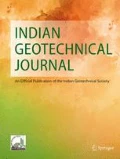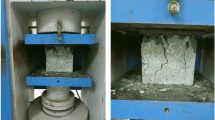Abstract
The reinforced cement concrete cantilever retaining wall is the most common type of retaining wall used in hillside roads, canals and bridge abutments. Methods for developing low-cost and low-weight designs of reinforced concrete retaining structures have been the subject of research using optimization tools. However, for an appropriate techno-commercial decision making, an ideal optimization method should give the optimized cost vis-à-vis corresponding factor of safety (FOS) against external stability like bearing, sliding, eccentricity and overturning. In this paper the optimum design of retaining wall is presented in multi-objective framework using elitist non-dominated sorting genetic algorithm (NSGA-II) considering both the cost and FOS as trade-off solutions. A set of effective Pareto optimal set was discussed indicating the efficacy of NSGA-II in finding out distinct and number of Pareto solutions. Optimum dimension of the retaining wall is also presented in terms of non-dimensional form for benefit of the professional engineers.













Similar content being viewed by others
References
Rhomberg EJ, Street WM (1981) Optimal design of retaining walls. J Struct Div ASCE 107(5):992–1002
Fang YS, Chen TJ, Wu BF (1994) Passive earth pressures with various wall movements. J Geotech Eng ASCE 120(8):1307–1323
Alshawi FAN, Mohammed AI, Farid BJ (1988) Optimum design of tied-back retaining walls. Struct Eng (London) 66(6):97–105
Keskar AV, Adidam SR (1989) Minimum cost design of a cantilever retaining wall. Indian Concr J 63(8):401–405
Saribas A, Erbatur F (1996) Optimization and sensitivity of retaining structures. J Geotech Eng 122(8):649–656
Deb K (2001) Multi-objective optimization using evolutionary algorithms. Wiley, Chichester
Coello Coello C, Christiansen AD, Santos F (1997) A simple genetic algorithm for the design of reinforced concrete beams. Eng Comput 13(4):185–196
Rafiqa MY, Southcombea C (1998) Genetic algorithms in optimal design and detailing of reinforced concrete biaxial columns supported by a declarative approach for capacity checking. Comput Struct 69(4):443–457
Rajeev S, Krishnamoorthy CS (1998) Genetic algorithms-based methodology for design optimization of reinforced concrete frames. Comput Aided Civ Infrastruct Eng 13(1):63–74
Camp CV, Pezeshk S, Hansson H (2003) Flexural design of reinforced concrete frames using a genetic algorithm. J Struct Eng 129(1):105–115
Lee CL, Ahn J (2003) Flexural design of reinforced concrete frames by genetic algorithm. J Struct Eng 129(6):762–774
Lepš M, Šejnoha M (2003) New approach to optimization of reinforced concrete beams. Comput Struct 81(18–19):1957–1966
Sahab MG, Ashour AF, Toropov VV (2004) Cost optimisation of reinforced concrete flat slab buildings. Eng Struct 27(3):313–322
Govindaraj V, Ramasamy JV (2005) Optimum detailed design of reinforced concrete continuous beams using genetic algorithms. Comput Struct 84(1–2):34–48
Kwak HG, Kim J (2008) Optimum design of reinforced concrete plane frames based on predetermined section database. Comput Aided Des 40(3):396–408
Kwak HG, Kim J (2009) An integrated genetic algorithm complemented with direct search for optimum design of RC frames. Comput Aided Des 41(7):490–500
Ceranic B, Fryer C, Baines RW (2001) An application of simulated annealing to the optimum design of reinforced concrete retaining structures. Comput Struct 79(17):1569–1581
Yepes V, Alcala J, Perea C, González-Vidosa F (2008) A parametric study of optimum earth-retaining walls by simulated annealing. Eng Struct 30(3):821–830
Paya I, Yepes V, González-Vidosa F, Hospitaler A (2008) Multi-objective optimization of concrete building frames by simulated annealing. Comput Aided Civ Infrastruct Eng 23(8):596–610
Perea C, Alcala J, Yepes V, González-Vidosa F, Hospitaler A (2008) Design of reinforced concrete bridge frames by heuristic optimization. Adv Eng Softw 39(8):676–688
Paya-Zaforteza I, Yepes V, Hospitaler A, González-Vidosa F (2009) CO2-optimization of reinforced concrete frames by simulated annealing. Eng Struct 31(7):1501–1508
Ahmadi-Nedushan B, Varaee H (2009) Optimal design of reinforced concrete retaining walls using a swarm intelligence technique. In: Proceedings of 1st international conference on soft computing technology in civil, structural and environmental engineering, Civil-Comp Press, Stirlingshire, UK
Kaveh A, Abadi ASM (2010) Harmony search based algorithm for the optimum cost design of reinforced concrete cantilever retaining walls. Int J Civ Eng 9(1):1–8
Camp CV, Akin A (2012) Design of retaining walls using big bang-big crunch optimization. J Struct Eng 138:438–448
Coello CAC, Veldhuizen DAV, Lamont GB (2002) Evolutionary algorithms for solving multi-objective problems. Kluwer, New York
Deb K, Dhar A (2011) Optimum design of stone column-improved soft soil using multiobjective optimization technique. Comput Geotech 38(1):50–57
Deb K, Dhar A, Bhagat P (2012) Evolutionary approach for optimal stability analysis of geosynthetic-reinforced stone column-supported embankments on clay. KSCE J Civ Eng 16(7):1185–1192
Delhi Schedule of Rates (DSR, 2007) Central Public works Department, Government of India, New Delhi
Srinivas N, Deb K (1994) Multi-objective function optimization using non-dominated sorting genetic algorithms. Evolut Comput J 2(3):221–248
Wang Y, Kulhawy FH (2008) Economic design optimization of foundations. J Geotech Geoenviron Eng 134(8):1097–1105
Author information
Authors and Affiliations
Corresponding author
Rights and permissions
About this article
Cite this article
Das, M.R., Purohit, S. & Das, S.K. Multi-objective Optimization of Reinforced Cement Concrete Retaining Wall. Indian Geotech J 46, 354–368 (2016). https://doi.org/10.1007/s40098-015-0178-y
Received:
Accepted:
Published:
Issue Date:
DOI: https://doi.org/10.1007/s40098-015-0178-y




